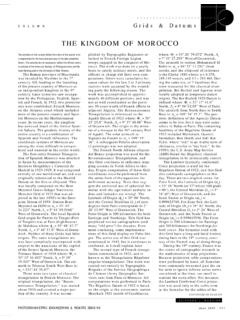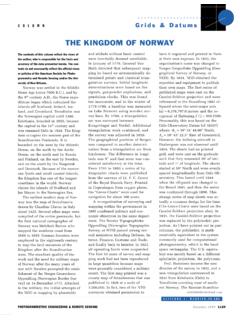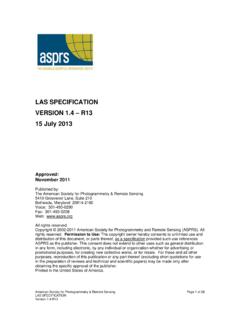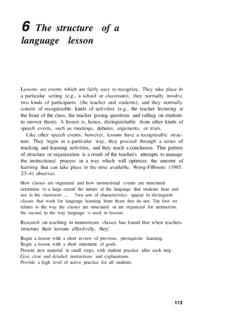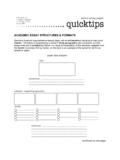Transcription of LAS Specification 1.4 - R15 - ASPRS
1 LAS Specification - R15 Release Information:Version Approved November 2011 Revision date 09 July 2019 PDF build date 09 July 2019 GitHub commit 72a54a4ab79bdb94eeea7977be2859c41fc119f0 GitHub repo by:The American Society for Photogrammetry & Remote Sensing425 Barlow Place, Suite 210 Bethesda, Maryland 20814-2160 Voice: 301-493-0290 Fax: 225-408-4422 Web: 2002-2019 American Society for Photogrammetry and Remote Sensing ( ASPRS ).All rights to Use:The copyright owner hereby consents to unlimited use and distributionof this document, or parts thereof, as a specificationprovided such use references ASPRS as thepublisher. This consent does not extend to other uses such as general distribution in any form,including electronic, by any individual or organization whether for advertising or promotionalpurposes, for creating new collective works, or for resale. For these and all other purposes,reproduction of this publication or any part thereof (excluding short quotations for use in thepreparation of reviews and technical and scientific papers) may be made only after obtaining thespecific approval of the in the United States of :1 Introduction.
2 , Scope, and Applicability .. Revision History .. of LAS to Previous Versions ..42 LAS Format Definition .. Compatibility (LAS - LAS ) .. Reference System (CRS) Representation .. Types .. Header Block .. Length Records (VLRs) .. Data Records .. Data Record Format 0 .. Data Record Format 1 .. Data Record Format 2 .. Data Record Format 3 .. Data Record Format 4 .. Data Record Format 5 .. Data Record Format 6 .. Data Record Format 7 .. Data Record Format 8 .. Data Record Format 9 .. Data Record Format 10 .. Variable Length Records (EVLRs) .. Compatibility for EVLRs .. 363 Coordinate Reference System VLRs (Required) .. Reference System Information .. Information Using WKT .. Math Transform WKT Record .. Coordinate System WKT Record .. Information Using GeoTIFF .. Record.
3 Record (Optional) .. Record (Optional) .. 404 Other Specification Defined VLRs (Optional) .. Lookup .. Area Description .. Bytes .. Packet Descriptor .. 445 Defined Extended Variable Length Records (EVLRs) .. Data Packets .. 466 LAS Domain Profiles .. Domain Profile Description .. 47iiLAS Specification - R15 American Society for Photogrammetry & Remote Sensing1 Purpose, Scope, and ApplicabilityThe LASer (LAS) file is intended to contain point cloud data records, including those derivedfrom lidar or other sources. The data will commonly be put into this format from software ( ,provided by hardware vendors), which combines GPS, IMU, and laser pulse range data to producepoints with X, Y, and Z coordinates. The purpose of LAS is to provide an open format that allowsdifferent hardware and software tools to exchange point cloud data in a common document reflects the fourth revision of the LAS format specification since its initial LAS Revision HistorySummary of LAS revisions (GitHub Issue numbers included when applicable): R11 - Approved Version (Nov 2011).
4 R12 - Errata (June 2012) - Typographical corrections: Corrected Public Header Size in descriptive paragraph to 375 bytes. Corrected two instances of Scan Angle Rank from Unsigned Char to Char . R13 - Added Domain Profile Section (July 2013). R14 - Multiple updates (March 2019): Aesthetic changes from migration to GitHub. Multiple capitalization & typo corrections. Updated ASPRS contact info. (I-305) Additional standard classifications 19-22 for PDRFs 6-10: (I-116, I-267)*Class 19 Overhead Structure in PDRFs 6-10.*Class 20 Ignored Ground.*Class 21 Snow.*Class 22 Temporal Exclusion. Added OGC endorsement. (I-318) Added minimum PDRF sizes to attribute tables. (I-479) Section reorganization: (I-5710)*Addition of Table of Contents with section numbers. ( I-2711, I-4912)*Divided Defined Variable Length Records section into Coordinate Reference Sys-tem VLRs section (s3) and Other Specification Defined VLRs (s4).
5 5 INTRODUCTIONPage 1 LAS Specification - R15 American Society for Photogrammetry & Remote Sensing*Expanded EVLR discussion in Legacy Compatibility section ( ) and movedLegacy Compatibility section to EVLR definition (now ).*Swapped order of LAS Revision History (now ) and LAS Additions(now ).*Rearranged paragraphs in Extra Bytes VLR description. Deprecated tuple and triple extra byte data types. (I-113)*Added explanation and example of implicit arrays from descriptor names. Clarified that ExtraByte min/max should be an untransformed value. (I-414) Clarified that Legacy Point Counts should be set to zero if using non-legacy PDRFs.(I-1215) Clarified Full Waveform descriptions and added wiki link. (I-916) Renamed X(t), Y(t), and Z(t) from waveform packets to Parametric dx/dy/dz. PDRF9 now correctly requires Scanner Channel like other PDRFs. (I-2917) Clarified origin date/time for Adjusted Standard GPS Time.
6 (I-4018) Clarified null-termination of fixed-lengthchararrays, especially VLR Description.(I-4619) Clarified relationship between FileSourceID and PointSourceID. (I-5920) Added language to support technologies other than conventional linear-mode lidarscanners. (I-3521)*Clarified and renamed Synthetic Return Numbers Global Encoding bit.*Clarified Synthetic point classification flag.*Clarified validity of zero-value PointSourceID.*Unified Return Number and Number of Returns descriptions between legacy andnon-legacy PDRFs.*Clarified Scan Direction and Edge of Flight Line Flags for non-rotational systems. Added wiki link for Project ID examples. (I-3822) R15 - Errata and typo corrections for R14 (July 2019): Minor editorial punctuation corrections. (I-7823) Fixed unintended reordering of Min/Max XYZ in R14 LAS header. (I-7924) Added missing Scanner Channel field in note about PDRF6-10 bit field. (I-8025)For detailed information on changes in revisions R14 and newer, review the inline differencingprovided on the GitHub INTRODUCTIONPage 2 LAS Specification - R15 American Society for Photogrammetry & Remote Comparison of LAS to Previous VersionsThe additions of LAS include: Backward compatibility with LAS LAS when payloads consist of only legacycontent.
7 LAS mode which supports: Extension of offsets and field sizes to support full 64 bit. Support for up to 15 returns per outgoing pulse. Extension of the Point Class field to support 256 classes. Definition of several new ASPRS standard classes. Extension of the Scan Angle field to 2 bytes to support finer angle resolution. Addition of a Sensor Channel bit field to support mobile mapping systems. Addition of Well Known Text (WKT) definitions for Coordinate Reference Systems. Addition of an Overlap bit to indicate points in the overlap region while maintainingthe class definition. Addition of an (optional)Extra BytesVariable Length Record to describe extra bytes stored with each point. Other minor changes: Added definitions for LAS Domain Profile and LAS Domain Profile Description . Added links to official LAS wiki: ConformanceThe data types used in the LAS format definition are conformant to the 1999 ANSI C LanguageSpecification (ANSI/ISO/IEC 9899:1999 ( C99 ).)
8 ASPRSThe American Society for Photogrammetry & Remote Sensing ( ASPRS ) is the owner of the LASS pecification. The standard is maintained by committees within the organization as directed by theASPRS Board of Directors. Questions related to this standard can be directed to ASPRS : Online at By phone at 301-493-0290 By email at or By mail at 425 Barlow Place, Suite 210, Bethesda, Maryland 20814-21601. INTRODUCTIONPage 3 LAS Specification - R15 American Society for Photogrammetry & Remote OGCLAS has been recognized by the Open Geospatial Consortium (OGC27) in 2018 as an OGCC ommunity Standard. The OGC version of the document with forward material about stan-dards that LAS references and its status within the standard body can be found at recognition and activity on OGC referencing activities of LAS can be followed at INTRODUCTIONPage 4 LAS Specification - R15 American Society for Photogrammetry & Remote Sensing2 LAS Format DefinitionThe format contains binary data consisting of a public header block, any number of (optional)Variable Length Records (VLRs), the Point Data Records, and any number of (optional) ExtendedVariable Length Records (EVLRs).
9 All data are in little-endian format. The public header blockcontains generic data such as point numbers and point data bounds. We refer to the data content ofthe file as the payload. The Variable Length Records (VLRs) contain variable types of data including projection informa-tion, metadata, waveform packet information, and user application data. They are limited to a datapayload of 65,535 Extended Variable Length Records (EVLRs) allow a higher payload than VLRs and have theadvantage that they can be appended to the end of a LAS file. This allows, for example, addingprojection information to a LAS file without having to rewrite the entire 1: LAS Format DefinitionPublic Header BlockVariable Length Records (VLRs)Point Data RecordsExtended Variable Length Records (EVLRs)A LAS file that contains point record types 4, 5, 9, or 10 could potentially contain one blockof waveform data packets that is stored as the payload of any Extended Variable Length Record(EVLR).
10 Unlike other EVLRs, the Waveform Data Packets (if stored internally to the file) have theoffset to the storage header contained within the Public Header Block ( Start of Waveform DataPacket Record ). Legacy Compatibility (LAS - LAS )LAS moves the file specification from a 32 bit file structure (maximum value of232 1 4,294,967,295 UINT32_MAX) to a 64 bit file structure (264 1).To maintain the ability to place a LAS through LAS payload (point record types 0-5, Geo-TIFF coordinate reference system, referred to as Legacy payloads) in a LAS file structure, itis necessary to duplicate some of the fields within the LAS file structure. These duplicate fieldsare named Legacy xxx where xxx denotes the meaning of the LAS file writer who wishes to maintain backward compatibility must maintain both thelegacy fields and the equivalent non-legacy fields in synchronization. However, this is not possibleif the number of points exceeds UINT32_MAX, in which case the legacy fields must be set to a file writer is not maintaining backward compatibility, the legacy fields must always be set LAS FORMAT DEFINITIONPage 5 LAS Specification - R15 American Society for Photogrammetry & Remote SensingIf there is a discrepancy between a non-zero legacy field and the equivalent LAS field, the reader should use the legacy value to maintain the same behavior as a LAS through reader.
